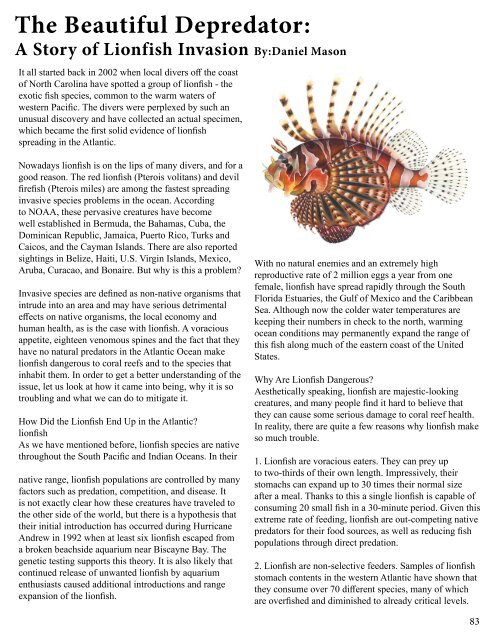Create successful ePaper yourself
Turn your PDF publications into a flip-book with our unique Google optimized e-Paper software.
The Beautiful Depredator:<br />
A Story of Lionfish Invasion By:Daniel Mason<br />
It all started back in 2002 when local divers off the coast<br />
of North Carolina have spotted a group of lionfish - the<br />
exotic fish species, common to the warm waters of<br />
western Pacific. The divers were perplexed by such an<br />
unusual discovery and have collected an actual specimen,<br />
which became the first solid evidence of lionfish<br />
spreading in the Atlantic.<br />
Nowadays lionfish is on the lips of many divers, and for a<br />
good reason. The red lionfish (Pterois volitans) and devil<br />
firefish (Pterois miles) are among the fastest spreading<br />
invasive species problems in the ocean. According<br />
to NOAA, these pervasive creatures have become<br />
well established in Bermuda, the Bahamas, Cuba, the<br />
Dominican Republic, Jamaica, Puerto Rico, Turks and<br />
Caicos, and the Cayman Islands. There are also reported<br />
sightings in Belize, Haiti, U.S. Virgin Islands, Mexico,<br />
Aruba, Curacao, and Bonaire. But why is this a problem?<br />
Invasive species are defined as non-native organisms that<br />
intrude into an area and may have serious detrimental<br />
effects on native organisms, the local economy and<br />
human health, as is the case with lionfish. A voracious<br />
appetite, eighteen venomous spines and the fact that they<br />
have no natural predators in the Atlantic Ocean make<br />
lionfish dangerous to coral reefs and to the species that<br />
inhabit them. In order to get a better understanding of the<br />
issue, let us look at how it came into being, why it is so<br />
troubling and what we can do to mitigate it.<br />
How Did the Lionfish End Up in the Atlantic?<br />
lionfish<br />
As we have mentioned before, lionfish species are native<br />
throughout the South Pacific and Indian Oceans. In their<br />
native range, lionfish populations are controlled by many<br />
factors such as predation, competition, and disease. It<br />
is not exactly clear how these creatures have traveled to<br />
the other side of the world, but there is a hypothesis that<br />
their initial introduction has occurred during Hurricane<br />
Andrew in 1992 when at least six lionfish escaped from<br />
a broken beachside aquarium near Biscayne Bay. The<br />
genetic testing supports this theory. It is also likely that<br />
continued release of unwanted lionfish by aquarium<br />
enthusiasts caused additional introductions and range<br />
expansion of the lionfish.<br />
With no natural enemies and an extremely high<br />
reproductive rate of 2 million eggs a year from one<br />
female, lionfish have spread rapidly through the South<br />
Florida Estuaries, the Gulf of Mexico and the Caribbean<br />
Sea. Although now the colder water temperatures are<br />
keeping their numbers in check to the north, warming<br />
ocean conditions may permanently expand the range of<br />
this fish along much of the eastern coast of the United<br />
States.<br />
Why Are Lionfish Dangerous?<br />
Aesthetically speaking, lionfish are majestic-looking<br />
creatures, and many people find it hard to believe that<br />
they can cause some serious damage to coral reef health.<br />
In reality, there are quite a few reasons why lionfish make<br />
so much trouble.<br />
1. Lionfish are voracious eaters. They can prey up<br />
to two-thirds of their own length. Impressively, their<br />
stomachs can expand up to 30 times their normal size<br />
after a meal. Thanks to this a single lionfish is capable of<br />
consuming 20 small fish in a 30-minute period. Given this<br />
extreme rate of feeding, lionfish are out-competing native<br />
predators for their food sources, as well as reducing fish<br />
populations through direct predation.<br />
2. Lionfish are non-selective feeders. Samples of lionfish<br />
stomach contents in the western Atlantic have shown that<br />
they consume over 70 different species, many of which<br />
are overfished and diminished to already critical levels.<br />
83


